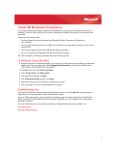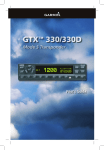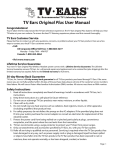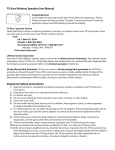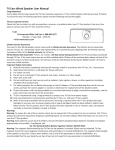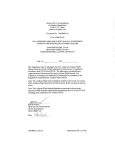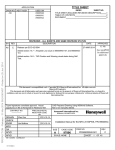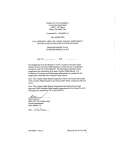Download GTN 6XX/7XX
Transcript
LOG OF REVISIONS Revision Number Page 1 All Complete Supplement See Page 1 2 12 Section 2.11 Modified limitation See Page 1 3 6 Table 1 Added new functions 8 Section 1.4 New section 11 Section 2.4 Modified limitation 12 Section 2.6 Added wire obstacles 14 Section 2.15 Modified limitation 15 16 17 18 19 24-25 Description FAA Approved See Page 1 Section 2.16, 2.17 & 2.18 Added limitations Section 3.1.1 Modified procedure, added note Section 3.2.3 Added note Section 3.2.8 Added Flight Stream 210 to procedure Section 4.1 Removed telephone audio deactivation procedure Section 7.5 Added wire obstacles 26 Section 7.9 Added Flight Stream 210 27 Section 7.10 Added wire obstacles 190-01007-A5 Rev. 3 Page 2 of 32 AFMS, GTN GPS/SBAS System (NO IFR GPS) FAA APPROVED LOG OF REVISIONS Revision Number Page 30-32 Description FAA Approved Sections 7.17-7.19 New sections AFMS, GTN GPS/SBAS System (NO IFR GPS) FAA APPROVED 190-01007-A5 Rev. 3 Page 3 of 32 Table of Contents SECTION Section 1. GENERAL 1.1 Garmin GTN Navigators 1.2 Capabilities 1.3 Electronic Flight Bag 1.4 Electronic Checklists 1.5 Definitions Section 2. LIMITATIONS 2.1 Cockpit Reference Guide 2.2 Kinds of Operation 2.3 Applicable System Software 2.4 SD/Database Card 2.5 Ground Operations 2.6 Terrain Proximity Function (All Units) 2.7 TAWS Function (Optional) 2.8 Datalinked Weather Display (Optional) 2.9 Traffic Display (Optional) 2.10 StormScope® Display (Optional) 2.11 Flight Planner/Calculator Functions 2.12 Glove Use / Covered Fingers 2.13 Demo Mode 2.14 Active Weather RADAR 2.15 Telephone Audio 2.16 Multi Crew Aircraft (GMA 35 Only) 2.17 Wire Obstacle Database 2.18 Portable Electronic Devices Section 3. EMERGENCY PROCEDURES 3.1 Emergency Procedures 3.2 Abnormal Procedures Section 4. NORMAL PROCEDURES 4.1 Unit Power On 4.2 Before Takeoff 4.3 HSI and EHSI Operation 4.4 Autopilot Operation 4.5 Coupling the Autopilot during approaches 4.6 Telephone & SMS Text (Optional) Section 5. PERFORMANCE Section 6. WEIGHT AND BALANCE Section 7. SYSTEM DESCRIPTIONS 7.1 Pilot’s Guide 7.2 Leg Sequencing 7.3 Auto ILS CDI Capture 7.4 Activate GPS Missed Approach 7.5 Terrain Proximity and TAWS 190-01007-A5 Rev. 3 Page 4 of 32 PAGE 6 6 8 8 8 8 10 10 10 10 11 12 12 12 13 13 13 14 14 14 14 14 15 15 15 16 16 17 19 19 19 20 20 21 22 22 22 23 23 23 23 23 24 AFMS, GTN GPS/SBAS System (NO IFR GPS) FAA APPROVED 7.6 7.7 7.8 7.9 7.10 7.11 7.12 7.13 7.14 7.15 7.16 7.17 7.18 7.19 GMA 35 Audio Panel (Optional) Traffic System (Optional) StormScope® (Optional) Power Databases and Flight Plan Waypoints/Procedures External Switches Airspace Depiction and Alerts GDL 88 ADS-B Traffic System Interface (Optional) GWX 70 Weather Radar (Optional) Charts (Optional) Transponder Control (Optional) Telephone Audio (Optional) Depiction of Obstacles and Wires Flight Stream 210 (Optional) AFMS, GTN GPS/SBAS System (NO IFR GPS) FAA APPROVED 25 25 26 26 27 28 28 29 30 30 30 30 31 32 190-01007-A5 Rev. 3 Page 5 of 32 Section 1. GENERAL 1.1 Garmin GTN Navigators The Garmin GTN navigation system is a GPS system with a Satellite Based Augmentation System (SBAS), comprised of one or more Garmin TSO-C146c GTN 625, 635, 650, 725, or 750 navigator(s) and one or more Garmin approved GPS/SBAS antenna(s). GTN 635 GTN 650 GTN 725 GTN 750 GPS SBAS Navigation (Not approved for IFR navigation) VHF Com Radio, 118.00 to 136.990, MHz, 8.33 or 25 kHz increments VHF Nav Radio, 108.00 to 117.95 MHz, 50 kHz increments LOC and Glideslope non-precision and precision approach guidance for Cat 1 minimums, 328.6 to 335.4 MHz tuning range Moving map including topographic, terrain, aviation, and geopolitical data Display of datalink weather products, SiriusXM, FIS-B, Connext ( all optional) Control and display of airborne weather radar (optional) Display of terminal procedures data (optional) Display of traffic data, including ADS-B (optional) Display of StormScope® data (optional) Display of marker beacon annunciators (optional) Remote audio panel control (optional) Remote transponder control (optional) Remote audio entertainment datalink control (optional TSO-C151c Class B TAWS (optional) Supplemental calculators and timers Control of GSR 56 Iridium Satellite Phone and SMS Text (optional) Control of Flight Stream 210 (optional) GTN 625 GTN system functions are shown in Table 1. X X X X X X X X X X X X X X X X X X X X X X X X X X X X X X X X X X X X X X X X X X X X X X X X X X X X X X X X X X X X X X X X X X X X X X Table 1 – GTN Functions The GPS navigation functions and optional VHF communication and navigation radio functions are operated by dedicated hard keys, a dual concentric rotary knob, or the touchscreen. 190-01007-A5 Rev. 3 Page 6 of 32 AFMS, GTN GPS/SBAS System (NO IFR GPS) FAA APPROVED Figure 1 - GTN 750 Control and Display Layout Figure 2 - GTN 635/650 Control and Display Layout AFMS, GTN GPS/SBAS System (NO IFR GPS) FAA APPROVED 190-01007-A5 Rev. 3 Page 7 of 32 1.2 Capabilities The GTN system and associated navigation interface in this aircraft have the following capability, in addition to the core multifunction display capability: VHF Communication Radio Primary VHF Navigation TSO-C151c Terrain Awareness and Warning System – See section 2.7 1.3 Electronic Flight Bag The GTN 750/725 are operationally suitable as Class 3 Hardware, Type B Software in accordance with AC 120-76B EFB electronic aeronautical information when using current FliteChart or ChartView data. 1.4 Electronic Checklists The GTN checklist functions are designed to DO-178B software design assurance level B and support a minor failure classification. While this STC does not grant operational approval for operators requiring such approval, there are no limitations precluding operators from obtaining their own operational approval for the checklist function. 1.5 Definitions The following terminology is used within this document: ADS-B: Automatic Dependent Surveillance Broadcast AEG: Aircraft Evaluation Group (FAA) APR: Approach CDI: Course Deviation Indicator EFB: Electronic Flight Bag EHSI: Electronic Horizontal Situation Indicator FIS-B: Flight Information Services Broadcast GPS: Global Positioning System GPSS: GPS Roll Steering GTN: Garmin Touchscreen Navigator HOT: Hazardous Obstacle Transmission wires HSI: Horizontal Situation Indicator IFR: Instrument Flight Rules ILS: Instrument Landing System LNAV: Lateral Navigation LOC: Localizer LOC-BC: Localizer Backcourse LP: Localizer Performance 190-01007-A5 Rev. 3 Page 8 of 32 AFMS, GTN GPS/SBAS System (NO IFR GPS) FAA APPROVED LPV: NOTAM: OBS: PED: RMT: SBAS: SD: SUSP: TAS: TAWS: TCAS: TFR: TIS: VHF: VFR: VLOC: VMC: VOR: XFR: Localizer Performance with Vertical Guidance Notice to Airmen Omnibearing Select Portable Electronic Device Remote Satellite Based Augmentation System Secure Digital Suspend Traffic Awareness System Terrain Awareness and Warning System Traffic Collision Avoidance System Temporary Flight Restriction Traffic Information Service Very High Frequency Visual Flight Rules VOR/Localizer Visual Meteorological Conditions VHF Omnidirectional Range Transfer AFMS, GTN GPS/SBAS System (NO IFR GPS) FAA APPROVED 190-01007-A5 Rev. 3 Page 9 of 32 Section 2. LIMITATIONS 2.1 Cockpit Reference Guide The Garmin GTN 6XX or GTN 7XX Cockpit Reference Guide, part number and revision listed below (or later revisions), must be immediately available to the flight crew whenever navigation is predicated on the use of the GTN. GTN 6XX Cockpit Reference Guide GTN 7XX Cockpit Reference Guide P/N 190-01004-04 Rev C P/N 190-01007-04 Rev C 2.2 Kinds of Operation This AFM supplement does not grant approval for IFR operations to aircraft limited to VFR operations. The GPS navigation capability of this unit cannot be used as primary navigation for IFR operations. This system is placarded in close proximity to the GTN: “GPS LIMITED TO VFR USE ONLY”. 2.3 Applicable System Software This AFMS/AFM is applicable to the software versions shown in Table 2. The Main and GPS software versions are displayed on the start-up page immediately after power-on. All software versions displayed in Table 2 can be viewed on the System – System Status or Connext Setup pages. Software Item Main SW Version GPS SW Version Com SW Version Nav SW Version Flight Stream 210 190-01007-A5 Rev. 3 Page 10 of 32 Software Version (or later FAA Approved versions for this STC) 5.13 5.0 2.13 6.02 2.11 Table 2 - Software Versions AFMS, GTN GPS/SBAS System (NO IFR GPS) FAA APPROVED 2.4 SD/Database Card It is required that the SD/database card be present in the unit at all times. The card must not be removed or inserted during flight and/or while the GTN is powered on. NOTE Removal of the SD card will result in certain features/databases not being available and/or slow system performance. AFMS, GTN GPS/SBAS System (NO IFR GPS) FAA APPROVED 190-01007-A5 Rev. 3 Page 11 of 32 2.5 Ground Operations Do not use SafeTaxi or Chartview functions as the basis for ground maneuvering. SafeTaxi and Chartview functions do not comply with the requirements of AC 20-159 and are not qualified to be used as an airport moving map display (AMMD). SafeTaxi and Chartview are to be used by the flight crew to orient themselves on the airport surface to improve flight crew situational awareness during ground operations. 2.6 Terrain Proximity Function (All Units) Terrain, point obstacle, and wire obstacle information appears on the map and terrain display pages as red and amber terrain, obstacles, or wires and is depicted for advisory use only. Aircraft maneuvers and navigation must not be predicated upon the use of the terrain display. Terrain, obstacle and wire information is advisory only and is not equivalent to warnings provided by TAWS. The terrain display is intended to serve as a situational awareness tool only. By itself, it may not provide either the accuracy or the fidelity on which to base decisions and plan maneuvers to avoid terrain or obstacles. NOTE Terrain and TAWS are separate features and mutually exclusive. If “TAWS B” is shown on the bottom right of the dedicated terrain page, then TAWS is installed. 2.7 TAWS Function (Optional) Flight crews are authorized to deviate from their current ATC clearance to the extent necessary to comply with TAWS warnings. Navigation must not be predicated upon the use of TAWS. If an external TAWS annunciator panel is installed in the aircraft, this annunciator panel must be fully functional in order to use the TAWS system. NOTE Terrain and TAWS are separate features and mutually exclusive. If “TAWS B” is shown on the bottom right of the dedicated terrain page, then TAWS is installed. 190-01007-A5 Rev. 3 Page 12 of 32 AFMS, GTN GPS/SBAS System (NO IFR GPS) FAA APPROVED 2.8 Datalinked Weather Display (Optional) This limitation applies to datalinked weather products from SiriusXM via a GDL 69/69A, FIS-B via a GDL 88, and Connext via a GSR 56. Do not use data link weather information for maneuvering in, near, or around areas of hazardous weather. Information provided by data link weather products may not accurately depict current weather conditions. Do not use the indicated data link weather product age to determine the age of the weather information shown by the data link weather product. Due to time delays inherent in gathering and processing weather data for data link transmission, the weather information shown by the data link weather product may be significantly older than the indicated weather product age. Do not rely solely upon data link services to provide Temporary Flight Restriction (TFR) or Notice to Airmen (NOTAM) information. Not all TFRs and NOTAMS can be depicted on the GTN. 2.9 Traffic Display (Optional) Traffic may be displayed on the GTN when connected to an approved optional TCAS I, TAS, TIS, or ADS-B traffic device. These systems are capable of providing traffic monitoring and alerting to the flight crew. Traffic shown on the display may or may not have traffic alerting available. The display of traffic is an aid to visual acquisition and may not be utilized for aircraft maneuvering. 2.10 StormScope® Display (Optional) StormScope® lightning information displayed by the GTN is limited to supplemental use only. The use of the StormScope® lightning data on the display for hazardous weather (thunderstorm) penetration is prohibited. StormScope® lightning data on the display is intended only as an aid to enhance situational awareness of hazardous weather, not penetration. It is the flight crew’s responsibility to avoid hazardous weather using official weather data sources. When the GTN StormScope® page is operating without a heading source, as indicated by the “HDG N/A” label at the upper right corner of the StormScope ® page, strikes must be cleared after each heading change. AFMS, GTN GPS/SBAS System (NO IFR GPS) FAA APPROVED 190-01007-A5 Rev. 3 Page 13 of 32 2.11 Flight Planner/Calculator Functions The Fuel Planning page uses Fuel on Board or Fuel Flow as received from an on board fuel totalizer, as entered by the pilot at system startup, or as entered by the pilot when on the Fuel Planning page. This is not a direct indication of actual aircraft fuel flow or fuel on board and those values are only used for the Fuel Planning page. The fuel required to destination is only a calculated and predicted value based on the data entered into the planner. It is not a direct indication of how much fuel the aircraft will have upon reaching the destination. 2.12 Glove Use / Covered Fingers No device may be used to cover fingers used to operate the GTN unless the Glove Qualification Procedure located in the Pilot’s Guide/Cockpit Reference Guide has been successfully completed. The Glove Qualification Procedure is specific to a pilot / glove / GTN 725, 750 or GTN 625, 635, 650 combination. 2.13 Demo Mode Demo mode may not be used in flight under any circumstances. 2.14 Active Weather RADAR Radar is broadcasting energy while in Weather or Ground mapping modes. If the GTN system is configured to control an airborne weather radar unit, observe all safety precautions, including: Do not operate in the vicinity of refueling operations. Do not operate while personnel are in the vicinity (approximately 20 feet) of the radar sweep area. CAUTION If a radar system is installed, it generates microwave radiation and improper use, or exposure, may cause serious bodily injury. Do not operate the radar equipment until you have read and carefully followed the safety precautions and instructions in the weather radar user manual and/or pilot’s guide. 2.15 Telephone Audio Telephone audio must not be distributed to the pilot or co-pilot unless a phone call is active. CAUTION Failure to turn off telephone audio when the telephone is not in use may result in telephone ringer or text message aural notifications being received during critical phases of flight. 190-01007-A5 Rev. 3 Page 14 of 32 AFMS, GTN GPS/SBAS System (NO IFR GPS) FAA APPROVED 2.16 Multi Crew Aircraft (GMA 35 Only) For aircraft type certified with more than one required pilot, or operations requiring more than one pilot, the “Group Co-Pilot with Passenger” audio panel option must not be activated. This option is found in the Intercom Setup Menu when a Garmin GMA 35 audio panel is installed. 2.17 Wire Obstacle Database Only the “Obstacle/HOT Line” database may be used. Use of the “Obstacle/Wire” database is prohibited. The database version can be viewed on the start-up database verification or System- System Status pages. 2.18 Portable Electronic Devices This STC does not relieve the operator from complying with the requirements of 91.23 or any other operational regulation regarding portable electronic devices. AFMS, GTN GPS/SBAS System (NO IFR GPS) FAA APPROVED 190-01007-A5 Rev. 3 Page 15 of 32 Section 3. EMERGENCY PROCEDURES 3.1 Emergency Procedures 3.1.1 TAWS WARNING Red annunciator and aural “PULL UP”: Autopilot ...................................................................................... DISCONNECT Aircraft Controls ............................. INITIATE MAXIMUM POWER CLIMB Airspeed ..................................................... BEST ANGLE OF CLIMB SPEED After Warning Ceases: Altitude .....................................CLIMB AND MAINTAIN SAFE ALTITUDE Advise ATC of Altitude Deviation, if appropriate. NOTE Only vertical maneuvers are recommended, unless either operating in visual meteorological conditions (VMC), or the flight crew determines, based on all available information, that turning in addition to the vertical escape maneuver is the safest course of action, or both. NOTE TAWS annunciators external to the GTN may not indicate the exact threat causing the alert. Example: WIRE alerts may be annunciated as TERR or OBSTACLE on external devices. 190-01007-A5 Rev. 3 Page 16 of 32 AFMS, GTN GPS/SBAS System (NO IFR GPS) FAA APPROVED 3.2 Abnormal Procedures 3.2.1 LOSS OF COM RADIO TUNING FUNCTIONS If alternate COM is available: Communications .........................................................USE ALTERNATE COM If no alternate COM is available: COM RMT XFR key (if installed) ....... PRESS AND HOLD FOR 2 SECONDS NOTE This procedure will tune the active COM radio the emergency frequency 121.5, regardless of what frequency is displayed on the GTN. Certain failures of the tuning system will automatically tune 121.5 without flight crew action. 3.2.2 LOSS OF AUDIO PANEL FUNCTIONS (GMA 35 Only) Audio Panel Circuit Breaker ........................................................................ PULL NOTE This procedure will force the audio panel into fail safe mode which provides only the pilot with communications and only on a single COM radio. If any non GTN 750 COM is installed, communication will be only on that radio. If only a GTN 750 is installed in the aircraft, then the pilot will have only the GTN 750 COM available. No other audio panel functions including the crew and passenger intercom will function. 3.2.3 TAWS CAUTION (Terrain or Obstacle Ahead, Sink Rate, Don’t Sink) When a TAWS CAUTION occurs, take corrective action until the alert ceases. Stop descending or initiate either a climb or a turn, or both as necessary, based on analysis of all available instruments and information. NOTE TAWS annunciators external to the GTN may not indicate the exact threat causing the alert. Example: WIRE alerts may be annunciated as TERR or OBSTACLE on external devices. 3.2.4 TAWS INHIBIT The TAWS Forward Looking Terrain Avoidance (FLTA) and Premature Descent Alerts (PDA) functions may be inhibited to prevent alerting, if desired. Refer to GTN Cockpit Reference Guide for additional information. AFMS, GTN GPS/SBAS System (NO IFR GPS) FAA APPROVED 190-01007-A5 Rev. 3 Page 17 of 32 To Inhibit TAWS: Home Hardkey ............................................................................................PRESS Terrain Button .............................................................................................PRESS Menu Button ...............................................................................................PRESS TAWS Inhibit Button ...................................................... PRESS TO ACTIVATE 3.2.5 TER N/A and TER FAIL If the amber TER N/A or TER FAIL status annunciator is displayed, the system will no longer provide TAWS alerting or display relative terrain and obstacle elevations. The crew must maintain compliance with procedures that ensure minimum terrain and obstacle separation. 3.2.6 DATA SOURCE - HEADING SOURCE INOPERATIVE OR CONNECTION TO GTN LOST MESSAGE Without a heading source to the GTN, the following features will not operate: GPSS will not be provided to the autopilot for heading legs. The autopilot must be placed in HDG mode for heading legs. Map cannot be oriented to Heading Up. All overlaying traffic data from a TAS/TCAS I or GDL 88 interfaced to an on board traffic system on the main map display. The flight crew must use the dedicated traffic page on the GTN system to display TAS/TCAS I or GDL 88 traffic data. All overlaying StormScope® data on the main map display. The flight crew must use the dedicated StormScope® page on the GTN system to display StormScope® data. StormScope® must be operated in accordance with Section 7.8 when no heading is available. 3.2.7 DATA SOURCE – PRESSURE ALTITUDE SOURCE INOPERATIVE OR CONNECTION TO GTN LOST MESSAGE Without a barometric altitude source to the GTN, the following features will not operate: Automatic leg sequencing of legs requiring an altitude source. The flight crew must manually sequence altitude legs, as prompted by the system. 3.2.8 UNRECOVERABLE LOSS OF ALL ELECTRICAL GENERATORS OR ALTERNATORS Remove power from all equipment which is not necessary for flight, including GTN #2 (NAV/GPS 2, COM 2) and the Flight Stream 210 (BT LINK), if installed. 190-01007-A5 Rev. 3 Page 18 of 32 AFMS, GTN GPS/SBAS System (NO IFR GPS) FAA APPROVED Section 4. NORMAL PROCEDURES Refer to the Cockpit Reference Guide defined in Section 2.1 of this document or the Pilot’s Guide defined in Section 7.1 for normal operating procedures and a complete list of system messages and associated flight crew actions. This includes all GPS operations, VHF communication and navigation, traffic, data linked weather, StormScope®, TAWS, and Multi-Function Display information. The GTN requires a reasonable degree of familiarity to avoid becoming too engrossed at the expense of basic instrument flying in IMC and basic see-andavoid in VMC. Garmin provides training tools with the Pilot’s Guide and PC based simulator. Pilots should take full advantage of these training tools to enhance system familiarization. 4.1 Unit Power On Database.......................................................... REVIEW EFFECTIVE DATES Self Test .................................... VERIFY OUTPUTS TO NAV INDICATORS Self Test - TAWS Remote Annunciator: PULL UP ............................................................................ ILLUMINATED TERR .................................................................................. ILLUMINATED TERR N/A .......................................................................... ILLUMINATED TERR INHB ....................................................................... ILLUMINATED Self Test - GPS Remote Annunciator: VLOC ................................................................................. ILLUMINATED GPS ..................................................................................... ILLUMINATED 4.2 Before Takeoff System Messages and Annunciators ............................................ CONSIDERED AFMS, GTN GPS/SBAS System (NO IFR GPS) FAA APPROVED 190-01007-A5 Rev. 3 Page 19 of 32 4.3 HSI and EHSI Operation If an HSI is used to display navigation data from the GTN the pilot should rotate the course pointer as prompted on the GTN. If an EHSI is used to display navigation data from the GTN the course pointer may autoslew to the correct course when using GPS navigation. When using VLOC navigation the course pointer will not autoslew and must be rotated to the correct course by the pilot. For detailed information about the functionality of the EHSI system, refer to the FAA approved Flight Manual or Flight Manual Supplement for that system. CAUTION The pilot must verify the active course and waypoint for each flight plan leg. The pilot must verify proper course selection each time the CDI source is changed from GPS to VLOC. 4.4 Autopilot Operation The GTN may be coupled to an optional autopilot, if installed in the aircraft, when operating as prescribed in the LIMITATIONS section of this manual. Autopilots coupled to the GTN system in an analog (NAV) mode will follow GPS or VHF navigation guidance as they would with existing VOR receivers. Autopilots that support GPSS or GPS Roll Steering in addition to the analog course guidance will lead course changes, fly arcing procedures, procedure turns, and holding patterns if coupled in GPSS mode. CAUTION The GTN cannot provide course deviation to the autopilot for heading legs. Some autopilots do not allow the use of GPSS when course deviation is not provided. For autopilot operating instructions, refer to the FAA approved Flight Manual or Flight Manual Supplement for the autopilot. 190-01007-A5 Rev. 3 Page 20 of 32 AFMS, GTN GPS/SBAS System (NO IFR GPS) FAA APPROVED 4.5 Coupling the Autopilot during approaches The GTN may be coupled to an optional autopilot, if installed in the aircraft, when operating as prescribed in the LIMITATIONS section of this manual. CAUTION When the CDI source is changed on the GTN, autopilot mode may change. Confirm autopilot mode selection after CDI source change on the GTN. Refer to the FAA approved Flight Manual or Flight Manual Supplement for the autopilot. Analog only autopilots should use APR mode for coupling to LNAV approaches. Autopilots which support digital roll steering commands (GPSS) may utilize NAV mode and take advantage of the digital tracking during LNAV only approaches. This installation prompts the flight crew and requires the pilot to enable the approach outputs just prior to engaging the autopilot in APR mode. To couple an approach: Once established on the final approach course with the final approach fix as the active waypoint, the GTN will issue a flashing message indication. Flashing Message Button ............................................................. PRESS “Enable APR Output” Button ...................................................... PRESS If coupled, Autopilot will revert to ROL mode at this time. Autopilot .............................................ENGAGE APPROACH MODE This installation supports coupling to the autopilot in approach mode once vertical guidance is available. To couple an approach: Once established on the final approach course with the final approach fix as the active waypoint, the GTN will enable vertical guidance. Vertical Guidance .........................................CONFIRM AVAILABLE Autopilot .............................................ENGAGE APPROACH MODE The installation does not support any vertical capture or vertical tracking. AFMS, GTN GPS/SBAS System (NO IFR GPS) FAA APPROVED 190-01007-A5 Rev. 3 Page 21 of 32 4.6 Telephone & SMS Text (Optional) Audio from the GSR 56 Iridium datalink is routed through the aircraft’s audio panel. Audio from the GSR 56 must be deactivated (turned off) unless making a phone call. The primary indication of an incoming phone call or SMS text are the visual indications on the GTN. Section 5. PERFORMANCE No change. Section 6. WEIGHT AND BALANCE See current weight and balance data. 190-01007-A5 Rev. 3 Page 22 of 32 AFMS, GTN GPS/SBAS System (NO IFR GPS) FAA APPROVED Section 7. SYSTEM DESCRIPTIONS 7.1 Pilot’s Guide The Garmin GTN 6XX or GTN 7XX Pilot’s Guide, part number and revision listed below, contain additional information regarding GTN system description, control and function. The Pilot’s Guides do not need to be immediately available to the flight crew. GTN 6XX Pilot’s Guide GTN 7XX Pilot’s Guide P/N 190-01004-03 Rev H or later P/N 190-01007-03 Rev H or later 7.2 Leg Sequencing The GTN supports all ARINC 424 leg types. Certain leg types require altitude input in order to sequence (course to altitude, for example). If a barometric corrected altitude source is not interfaced to the GTN, a popup will appear prompting the flight crew to manually sequence the leg once the altitude prescribed in the procedure is reached. This installation has a barometric corrected altitude source. The GTN will automatically sequence altitude legs. This installation does not have a barometric corrected altitude source. The flight crew will be prompted to manually sequence altitude legs. 7.3 Auto ILS CDI Capture Auto ILS CDI Capture will not automatically switch from GPS to VLOC for LOC-BC or VOR approaches. 7.4 Activate GPS Missed Approach This installation will autoswitch from VLOC to GPS when the “Activate GPS Missed Approach” button is pressed. This installation will not autoswitch from VLOC to GPS when the “Activate GPS Missed Approach” button is pressed. The pilot must manually switch from VLOC to GPS if GPS guidance is desired after the missed approach point. AFMS, GTN GPS/SBAS System (NO IFR GPS) 190-01007-A5 Rev. 3 Page 23 of 32 7.5 Terrain Proximity and TAWS CAUTION Not all obstacles and wires are contained in the Obstacle/HOT Line database. The system provides depiction (and alerts, if TAWS is installed) only for obstacles and wires contained in the database. NOTE The area of coverage may be modified as additional terrain data sources become available. This installation supports Terrain Proximity. No aural or visual alerts for terrain or obstacles are provided. Terrain Proximity does not satisfy the TAWS requirement of 91.223. This installation supports TAWS B. Aural and visual alerts will be provided. This installation does support the TAWS requirement of 91.223. To avoid unwanted alerts, TAWS may be inhibited when landing at an airport that is not included in the airport database. Terrain on the dedicated terrain page or main map overlay is depicted in the following manner: Terrain more than 1,000 ft below the aircraft is not depicted, or depicted as black. Terrain between 1,000 ft and 100 ft below the aircraft is depicted as amber. Terrain within 100 ft below the aircraft, or above the aircraft, is depicted as red. Obstacles and wires on the dedicated terrain page or main map are depicted in the following manner: Obstacles and wires more than 2,000 ft below the aircraft are not depicted. Obstacles and wires between 2,000 ft and 1,000 ft below the aircraft are depicted as white. Obstacles and wires between 1,000 ft and 100 ft below the aircraft are depicted as amber. Obstacles and wires within 100 ft below the aircraft, or above the aircraft, are depicted as red. 190-01007-A5 Rev. 3 Page 24 of 32 AFMS, GTN GPS/SBAS System (NO IFR GPS) Multiple obstacles may be depicted using a single obstacle icon and an asterisk to indicate obstacle grouping is occurring. The color of the asterisk indicates the relative altitude of the tallest obstacle in the group. The asterisk does not indicate any information about the relative altitude or number of obstacles not being displayed in the obstacle group. The Garmin GTN 6XX or GTN 7XX Cockpit Reference Guide or Garmin GTN 6XX or GTN 7XX Pilot’s Guide provides additional information regarding terrain and obstacle colors and grouped obstacle icons. 7.6 GMA 35 Audio Panel (Optional) The GTN 725 and 750 can interface to a GMA 35 remotely mounted audio panel and marker beacon receiver. Controls for listening to various radios, activating the cabin speaker, clearance playback control, and marker beacon are accessed by pressing the “Audio Panel” button on the GTN display screen. Volume controls for the audio panel are accessed by pressing the “Intercom” button on the GTN display screen. 7.7 Traffic System (Optional) This system is configured for the following type of traffic system. The Garmin GTN 6XX or GTN 7XX Cockpit Reference Guide or Garmin GTN 6XX or GTN 7XX Pilot’s Guide provides additional information regarding the functionality of the traffic device. No traffic system is interfaced to the GTN. A TAS/TCAS I traffic system is interfaced to the GTN. A TIS traffic system is interfaced to the GTN. A TCAD traffic system is interfaced to the GTN. A Garmin GDL 88 ADS-B traffic system is interfaced to the GTN. A Garmin GDL 88 ADS-B traffic system is interfaced to the GTN. The GDL 88 ADS-B traffic system is also interfaced to an on board traffic system. AFMS, GTN GPS/SBAS System (NO IFR GPS) 190-01007-A5 Rev. 3 Page 25 of 32 7.8 StormScope® (Optional) When optionally interfaced to a StormScope® weather detection system, the GTN may be used to display the StormScope® information. Weather information supplied by the StormScope® will be displayed on the StormScope® page of the GTN system. For detailed information about the capabilities and limitations of the StormScope® system, refer to the documentation provided with that system. Heading Up mode: If the GTN system is receiving valid heading information, the StormScope ® page will operate in the heading up mode as indicated by the label “HDG UP” presented at the upper right corner of the display. In this mode, information provided by the StormScope® system is displayed relative to the nose of the aircraft and is automatically rotated to the correct relative position as the aircraft turns. Heading Not Available mode: If the GTN system is not receiving valid heading information, either because a compatible heading system is not installed, or the interfaced heading system has malfunctioned, the StormScope® page will continue to operate without a heading source and indicate “HDG N/A” in the upper right corner of the GTN display. In this mode, information provided by the StormScope ® system is displayed relative to the nose of the aircraft but is not automatically rotated to the correct relative position as the aircraft turns. When operating in this mode, StormScope® strikes must be cleared after each turn the aircraft performs. 7.9 Power Power to the GTN is provided through a circuit breaker labeled NAV/GPS (1/2). Power to the optional GTN COM is provided through a circuit breaker labeled COMM (1/2) Power to the optional GMA 35 is provided through a circuit breaker labeled AUDIO. Power to the optional Flight Stream 210 is provided through a circuit breaker labeled BT LINK. 190-01007-A5 Rev. 3 Page 26 of 32 AFMS, GTN GPS/SBAS System (NO IFR GPS) 7.10 Databases and Flight Plan Waypoints/Procedures Database versions and effective dates are displayed on the start-up database verification page immediately after power-on. Database information can also be viewed on the System – System Status page. The Obstacle Database has an area of coverage that includes the United States and Europe, and is updated as frequently as every 56 days. The HOT Line wire database only includes the continental United States and portions of Canada/Mexico. Only the Obstacle/HOT Line wire database may be used in accordance with the limitation found in section 2.17. If a flight plan contains a waypoint or procedure that does not correspond to a waypoint or procedure in the navigation database in use, the waypoint or procedure will become locked (depicted as “lockd”) in the flight plan. Flight plans with locked waypoints may be placed in the active flight plan portion of the system but no active navigation will be provided. The locked waypoint/procedure must be resolved by removing or replacing it with the correct waypoint/procedures in the flight plan before the system will provide active navigation. AFMS, GTN GPS/SBAS System (NO IFR GPS) 190-01007-A5 Rev. 3 Page 27 of 32 7.11 External Switches External switches may be installed and interfaced to the GTN. These switches may be stand alone, or integrated with a TAWS or GPS annunciator. Table 3 lists the switches and function they perform: Switch Label CDI COM CHAN DN COM CHAN UP COM RMT XFR NAV RMT XFR OBS OBS/SUSP TERR INHB Function Toggles between GPS / VLOC sources. This switch may be part of an external annunciator panel. Toggles down through the preset com frequencies. Toggles up through the preset com frequencies. Transfers the com active / standby frequencies. Transfers the nav active / standby frequencies. Performs an OBS or SUSP function. This switch is part of an external annunciator panel and is placarded with the following: “Green OBS indicates OBS or SUSP mode – GTN annunciator bar indicates which is active. Push OBS button to change OBS or SUSP mode.” Performs an OBS or SUSP function. Toggles the TAWS Inhibit function on/off. This switch is part of an external annunciator panel. The terrain display is still presented if TAWS is Inhibited. Table 3 – External Switches 7.12 Airspace Depiction and Alerts The GTN aides the flight crew in avoiding certain airspaces with Smart Airspace and airspace alerts. Smart Airspace de-emphasizes depicted airspace that is not near the aircraft’s current altitude. Airspace Alerts provide a message indication to the flight crew when the aircraft’s current ground track will intercept an airspace type that has been selected for alerting. NOTE Smart Airspace and Airspace Alerts are separate features. Turning on/off Smart Airspace does not affect Airspace Alerts, and vice versa. 190-01007-A5 Rev. 3 Page 28 of 32 AFMS, GTN GPS/SBAS System (NO IFR GPS) 7.13 GDL 88 ADS-B Traffic System Interface (Optional) The GDL 88 is an ADS-B traffic system that can interface to the GTN. The nose of the ownship symbol on both the GTN main map page and dedicated traffic page serves as the actual location of your aircraft. The center of the traffic target icon serves as the reported location for the target aircraft. Motion vectors for traffic may be displayed in either absolute or relative motion. The location of the traffic targets relative to the ownship are the same, regardless of the selected motion vector. Absolute motion vectors are colored either cyan or white, depending on unit configuration. Absolute motion vectors depict the reported track of the traffic target referenced to the ground. An absolute motion vector pointed towards your ownship symbol does not necessarily mean the traffic target is getting closer to your aircraft. Relative motion vectors are always colored green and depict the motion of the traffic target relative to your ownship symbol. The direction the traffic target is pointed may vary greatly from the motion vector and a target may be getting closer to your aircraft independent of the direction the target is pointed. A green relative motion vector pointed towards your ownship indicates that the traffic target is converging on your aircraft. If more than one target is occupying the same area of the screen, the GTN will combine the two or more traffic targets into one traffic group. The presence of an asterisk to the left of a target indicates that traffic has been grouped. The highest priority traffic target in the group is displayed to the pilot. When applied to airborne targets the asterisk will be displayed in white or cyan depending on the traffic depiction color used in the installation. The asterisk will be brown for grouped ground targets. The asterisk will not turn amber, even if an alerted target is included in the group. An alerted target may be placed in the same group as non-alerted targets. In this case, the alerted target will be displayed. Two alerted targets will not be placed in the same group. All alerted targets will be displayed on the screen. Traffic targets displayed on the dedicated traffic page may be selected in order to obtain additional information about a traffic target or to view all targets in a grouped target. When a grouped target is selected, the “Next” button on the dedicated traffic page will cycle through all targets located in close proximity to where the screen has been touched. AFMS, GTN GPS/SBAS System (NO IFR GPS) 190-01007-A5 Rev. 3 Page 29 of 32 7.14 GWX 70 Weather Radar (Optional) The GWX 70 Weather Radar uses Doppler technology to provide advanced features to the flight crew such as turbulence detection and ground clutter suppression. These features that rely on Doppler technology are only supported with on GWX 70 units that have a 12 inch antenna or lager. Turbulence detection is only supported at display ranges 40-160 nautical miles. NOTE Turbulence detection does not detect all turbulence, especially that which is occurring in clear air. The display of turbulence indicates the possibility of Severe or greater turbulence, as defined in the Aeronautical Information Manual. 7.15 Charts (Optional) The GTN 750/725 can display both procedure charts and weather data on the main map page at the same time. When datalinked Nexrad or Precipitation is overlaid on the main map page, the weather data is displayed below an overlaid procedure chart. When airborne weather radar is overlaid on the main map page, the radar data is displayed above an overlaid procedure chart. 7.16 Transponder Control (Optional) The GTN can be interfaced to a Garmin transponder for control and display of squawk code, mode, and additional transponder functions. The activation of the “Enable ES” button on the transponder page does not indicate the aircraft is in full compliance with an ADS-B Out solution in accordance with TSO-C166b (1090ES). Consult your transponder documentation for additional information. 7.17 Telephone Audio (Optional) Telephone audio distribution defaults to off on each power cycle of the GTN. Prior to utilizing the telephone function the crew must distribute telephone audio to the desired recipients. If the crew is utilizing the telephone function it is required that the telephone audio be turned off upon completing telephone usage. 190-01007-A5 Rev. 3 Page 30 of 32 AFMS, GTN GPS/SBAS System (NO IFR GPS) 7.18 Depiction of Obstacles and Wires 7.18.1 Dedicated Terrain Page The dedicated Terrain page will always depict point obstacles at zoom scales of 10 nm or less and depict wire obstacles at zoom scales of 5 nm or less. The obstacle or wire overlay icon (see Figure 3) will be shown near the bottom of the display when the obstacle or wire depiction is active based on the zoom scale. NOTE Only obstacles and wires within 2,000 ft vertically of the aircraft will be drawn on the Terrain page. It is therefore possible to have an obstacle or wire overlay icon displayed with no obstacles or wires being depicted on the display. Figure 3 – Obstacle Overlay Icon (Left), Wire Overlay Icon (Right) 7.18.2 Map Page The Map page may be configured to depict point obstacles and wire obstacles at various zoom scales by the pilot by using the Map page menu. The obstacle or wire overlay icon (see Figure 4) will be shown near the bottom of the display when the obstacle or wire overlay is active based on the current zoom scale and setting selected by the pilot. The settings chosen by the pilot on the Map page menu (including obstacle and wire display ranges) are saved over a power cycle. NOTE Only obstacles and wires within 2,000 ft vertically of the aircraft will be drawn on the Map page. It is therefore possible to have an obstacle or wire overlay icon displayed with no obstacles or wires being depicted on the display. NOTE The Map page may be configured by the pilot to not show any obstacles or wires at any zoom scale. Figure 4 – Obstacle Overlay Icon (Left), Wire Overlay Icon (Right) AFMS, GTN GPS/SBAS System (NO IFR GPS) 190-01007-A5 Rev. 3 Page 31 of 32 7.19 Flight Stream 210 (Optional) The Flight Stream 210 is a remotely mounted unit that provides the capability to interface Portable Electronic Devices (PEDs) to the GTN. Data such as traffic, flight plan, datalinked weather and entertainment audio information, and attitude information is sent form the Flight Stream 210 to the PED. The PED is capable of sending flight plans to the Flight Stream which will then be displayed on the GTN and controlling the datalinked entertainment audio. Garmin provides a list of tested and compatible devices that can be used with the Flight Stream 210. Connection to the Flight Stream 210 may be possible with devices other than those on the supported device list, but Bluetooth® stability and wireless data integrity cannot be guaranteed. For details about the Garmin supported devices and apps for use with the Flight Stream 210, please visit: http://garmin.com/connext/supported_devices 190-01007-A5 Rev. 3 Page 32 of 32 AFMS, GTN GPS/SBAS System (NO IFR GPS)

































